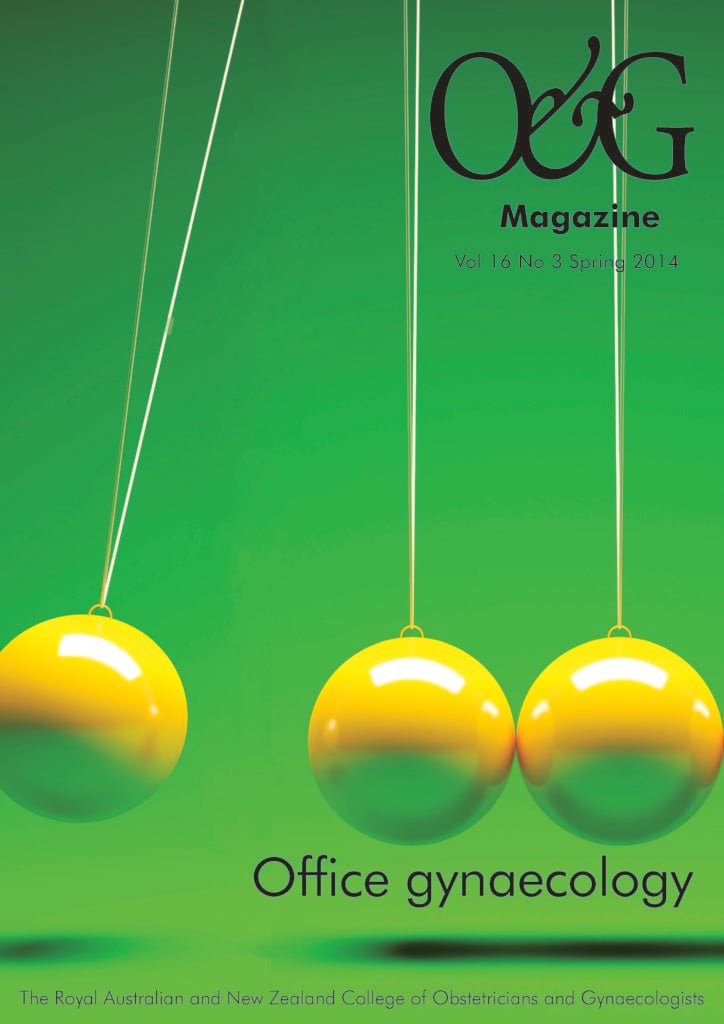A review of the basic fertility investigations for the general gynaecologist.
Some nine per cent of couples globally experience infertility.1 Although there are many definitions, it is generally accepted that infertility is defined following 12 months duration of regular unprotected sexual intercourse without conception.2 Where the woman is >35 years of age, six months duration is sufficient. Beyond this, it is encouraged that couples seek some basic assessment and investigations.
There is currently no Australian or New Zealand consensus guideline as to what investigations should be instituted. What is critical to consider is that the choice of investigations are cost effective (to patients and the health care system) and ensure a smooth and quick process of management for the couple for whom the process can be mentally and physically challenging.
History
It is important to see both partners. History from the couple should include information on her cycle and menstrual symptoms, past medical and surgical history for them both and significant family history and drug and occupational history. Time trying to conceive, frequency and timing of intercourse as well as sexual dysfunction is also important to ascertain. Specifically for a woman, it is important to check for an up-to-date Pap smear and she is on an appropriate folic acid supplement.3
Examination
The value of examining the female and male remains controversial. A UK survey found a lack of consensus among gynaecologists4 and concluded that large prospective studies were required. Pelvic examination of the female may illicit signs of causes of infertility, including deep infiltrating endometriosis5 or abnormal anatomy. For the male, studies suggest that routine urological examination may not contribute any additional information6, particularly if semen analysis is normal. However, others argue that men who present with infertility have a higher incidence of pathology, including testicular cancer and certainly, in the hands of someone experienced, male urological examination may reveal important pathology such as testicular atrophy, varicocele or congenitally absent vas deferens.
Investigations
Pre-conception screening
An infertility work-up should include pre-conception screening and counselling (see RANZCOG guideline on Pre-pregnancy Counselling C-Obs 3 (a)).3 For the woman, this includes rubella, HIV, hepatitis B and C and syphilis serology. Varicella and pertussis immunity and chlamydia screening should also be considered as per national guidelines. Discussion about healthy weight management and nutrition may also be salient. For the male, infectious diseases screening is also an important consideration (hepatitis B and C and HIV).
Female investigations
Ovarian reserve
A woman’s ovarian reserve (OR) is their reproductive potential as a function of the number and quality of remaining oocytes.7 Diminished ovarian reserve (DOR) is found in women whose response to stimulation or fecundity is reduced compared to women of similar age. There is great controversy in the literature as to whether ovarian reserve tests (ORT) can predict oocyte quality, quantity or fecundity and the goal of testing OR is to provide prognostic information on expected outcome in an assisted reproductive technology setting, as opposed to assessment of infertility.
Evidence of DOR does not necessarily equate with inability to conceive. Female age remains the best predictor of conception, ongoing pregnancy and live birth rates.7
Studies assessing the accuracy and reliability of various ORTs have been plagued by heterogeneity of populations and outcome measures as well as sensitivity/specificity of the tools.
Current research suggests antral follicle count on transvaginal ultrasound in the early follicular phase and serum anti-Müllerian hormone (AMH) levels are the most predictive of DOR, and consideration should be given to assessment of both, though perhaps only in the setting of planning for treatment and not as an initial assessment of infertility.
Ovulation
It is reasonable to think that a woman with regular cycles would be ovulatory; however, this is not always the case. Ovulatory disorders can be identified in 15–25 per cent of infertile couples8, so a detailed history on menstrual cycle is important. It is suggested that an objective and reliable measure of ovulation (mid-luteal serum progesterone measurement) is useful in infertile women.8 Serial basal body temperature (BBT) is simple and inexpensive, but owing to poor compliance and reliability is not recommended.8
Ovulation predictor kits’ using urinary LH determination of mid-cycle surge correlate well with peak serum LH; however, accuracy, ease of use and reliability may yield false-positive or false-negative results.8 In women where simpler tests fail to yield a result, hormone tracking combined with transvaginal ultrasound follicle tracking provides the best assessment of ovulatory dysfunction; however, it should be reserved for those women who are already in a treatment setting. Women who have clear ovulatory dysfunction on history should be considered for directed assessment of conditions such as polycystic ovarian syndrome, hyperprolactinemia, thyroid or other pituitary or hypothalamic disorders.
Hormones
In the setting of irregular or absent menstrual periods, it may be worth assessing for hyperprolactinemia; however, there is no evidence to suggest routine screening of serum prolactin levels in the asymptomatic female.9
It is recommended that thyroid function is assessed in infertile women.10,11 Both overt and subclinical hypothyroidism are associated with an increased risk of unexplained subfertility as well as poorer late pregnancy outcomes. TPO antibody positive females also have a higher incidence of subfertility. In the context of a TSH >2.5mU/L and positive TPO antibody status, there is evidence that treatment with low dose levothyroxine improves pregnancy outcomes.10
Tubal patency
Tubal disease is an important cause of infertility and should be excluded. Laparoscopic tubal chromotubation is the gold standard for assessing tubal patency; however, it carries higher surgical morbidity. Other forms of specific tubal assessment include hysterosalpingogram (HSG) or hysterosalpingo contrast sonography (HyCoSy). With both of these, findings suggestive of proximal tubal obstruction require further evaluation to exclude a false positive result from transient tubal/myometrial contraction or incorrect catheter positioning.
Imaging
Transvaginal ultrasound can be used to assess for anatomical causes of female infertility, including endometriomas, ovarian cysts, hydrosalpinges, leiomyomas and endometrial polyps. Given that Müllerian anomalies are more prevalent in an infertile population (three to 13 per cent)12, consideration should be given to a three-dimensional ultrasound for improved detection.11 Saline sonohysterography can also be used for detection of intracavity anomalies.
Owing to the ready availability of transvaginal ultrasound services in Australia and New Zealand, baseline investigation of female infertility should include this.
Surgery
The role of surgical investigation (laparoscopy +/- hysteroscopy) for female infertility is controversial, but many pathologies contribute to infertility (endometriosis, polyps, submucosal fibroids, hydrosalpinges) and treatment can significantly improve outcomes.13 Investigative surgery is most clearly indicated for those with symptoms, risk factors or abnormal imaging; its yield in asymptomatic women is low.8 Primary infertility is a risk factor for endometriosis and surgical intervention is best suited to mild/minimal disease to improve spontaneous fertility outcomes.14 A low threshold for undertaking surgical investigation may therefore be justified.
Genetic screening (male and/or female)
Cystic fibrosis (CF) is an autosomal recessive condition and has a carrier rate in Caucasian populations of one in 25, with a higher rate of carriage in an infertility population of one in 21.5.15 CF gene mutations are associated with causes infertility, such as congenital absence of the vas deferens.
Although there are currently no Australian or New Zealand guidelines, the American Congress of Obstetrics and Gynecology recommends pan-ethic screening and counselling for CF mutations as part of pre-conception planning.16 Consideration should also be given to screening of ethnic-specific gene mutations for disease such as sickle cell anaemia, α- and β-thalassemia and Tay Sachs disease; though some would argue that genetic screening may be best reserved for the treatment setting. A karyotype is not required in the initial assessment setting.
Male investigations
Semen analysis is the first-line investigation for the male and approximately one-third of infertility can be attributed to male factors alone.
The World Health Organisation’s manual on semen analysis remains the definitive reference range for laboratories performing analyses. These guidelines have been recently updated17 and results should be considered a guide only.
Table 1. The change in semen analysis parameters that has occurred from the original to the recent WHO manual.
| Measured parameter | WHO 1980 | WHO 2010 |
| Semen volume (ml) | >2 | >1.5 |
| Sperm concentration (106/ml) | >20 | >15 |
| Progressive motility (%) | >50 | >32 |
| Normal forms (%) | >15 | >4 |
Owing to the significant intra-individual variation, it is generally accepted that at least two semen analyses should be performed at least six weeks apart.
If persistent abnormal semen analyses are evident, consideration should be given to a baseline hormone profile (FSH, LH and testosterone) to indicate a central or peripheral cause that can then direct further investigation in a treatment setting.
Advanced sperm testing, including DNA integrity tests have limited prognostic value for natural or ART pregnancy. The American Society for Reproductive Medicine18 does not advocate routine screening.
References
- Boivin J, Bunting L, Collins JA, Nygren KG. International estimates of infertility prevalence and treatment-seeking: potential need and demand for infertility medical care. Human Reproduction. 2007; 22: 1506-12.
- The Practice Committee of the American Society for Reproductive Medicine. Definitions of infertility and recurrent pregnancy loss: a committee opinion. Fertility and Sterility. 2013; 99:63.
- The Royal Australian and New Zealand College of Obstetricians and Gynaecologists. Pre-pregnancy counseling (C-Obs 3 (a)). November 2012.
- Desai A, Jaiyesimi R. A survey of the value of routine intimate examination and related practices in subfertile couples. Journal of Obstetrics & Gynaecology. 2007; 27(8): 840-4.
- Bazot M, Lafont C, Rouzier R et al. Diagnostic accuracy of physical examination, transvaginal sonography, rectal endoscopic sonography, and magnetic resonance imaging to diagnose deep infiltrating endometriosis. Fertility and Sterility. 2009; 92(6): 1825- 33.
- Dunphy B, Kay R, Barratt C, Cooke I. Is routine examination of the male partner of any prognostic value in the routine assessment of couples who complain of involuntary infertility? Fertility and Sterility. 1989; 52(3): 454-6.
- The Practice Committee of the American Society for Reproductive Medicine. Testing and interpreting measures of ovarian reserve: a committee opinion. Fertility and Sterility. 2012; 98(6): 1407-15.
- The Practice Committee of the American Society for Reproductive Medicine. Diagnostic evaluation of the infertile female: a committee opinion. Fertility and Sterility. 2012; 98(2): 302-07.
- Glazener C, Kelly N, Hull M. Prolactin measurement in the investigation of infertility in women with a normal menstrual cycle. BJOG. 1987; 94(6): 535-8.
- Vissenberg R et al. Treatment of thyroid disorders before conception and in early pregnancy: a systematic review. Human Reproduction Update. 2012; 18(4): 360-373.
- Van den Boogaard E et al. Significance of (sub)clinical thyroid dysfunction and thyroid autoimmunity before conception and in early pregnancy: a systematic review. Human Reproduction Update. 2011; 17(5): 605-619.
- Saravelos SH, Cocksedge KA, Li TC. Prevalence and diagnosis of congenital uterine anomalies in women with reproductive failure: a critical appraisal. Human Reproduction Update. 2008; 14(5): 415-29.
- Hunter T, Hart R. Endoscopic surgery for female infertility: a review of current management. ANZJOG. 2009; 49(6): 588-93.
- Koch J, Rowan K, Rombauts L et al. Endometriosis and Infertility – a consensus statement from ACCEPT. ANZJOG 2012; 52(6): 513- 522.
- Field P, Martin N. CFTR mutation screening in an assisted reproductive clinic. ANZJOG 2011; 51: 536-539.
- ACOG Committee Opinion No. 486: Update on carrier screening for cystic fibrosis. American College of Obstetricians and Gynecologists Committee on Genetics. Obstetrics and Gynecology. 2011; 117(4): 1028.
- Jequier AM. Semen analysis: a new manual and its application to the understanding of semen and its pathology. Asian Journal of Andrology. 2010; 12(1): 11-13.
- The Practice Committee of the American Society for Reproductive Medicine. Diagnostic evaluation of the infertile male: a committee opinion. Fertility and Sterility 2012; 98(2): 294-301.






Leave a Reply